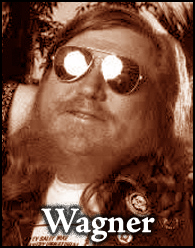Tuesday, April 14, 2009
posted by Leo Grin
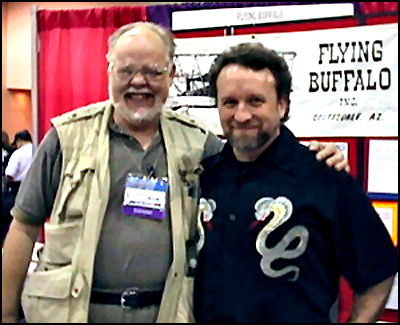
The late Dave Arneson (left) at a convention with former REHupan (and currently popular writer) Mike Stackpole.
The death of Dungeons & Dragons co-creator Dave Arneson last week brings to a close another chapter in the early history of role-playing games. What perhaps isn’t well known is the degree to which Arneson imbued D&D with a distinctly Howardian scarlet glow, an episodic sense of adventure that immediately reminds one of those original Weird Tales-era Conan stories. Here is Indy Cavalier, writing about Arneson in The Cimmerian V4n5 for October 2008:
Dave Arneson — D&D’s other creator, who has habitually avoided the spotlight shining on Gygax — also credits Howard’s Conan as an influence. Arneson was a tabletop miniatures wargamer who expanded on Gygax’s Chainmail miniatures rules, giving personalities and statistics to the small lead soldiers who delved into a keep to steal supplies. Arneson says his part in creating a breakthrough in the wargaming/fantasy aspects of role-playing (and the mapped-out dungeon) happened thusly: “I had spent the previous day watching about five monster movies on Creature Feature weekend, reading a Conan book (I cannot recall which one but I always thought they were much the same), and stuffing myself with popcorn, doodling on a piece of graph paper.” At Gen Con 1995, I asked Mr. Arneson directly about Howard’s influence on the creation of Dungeons & Dragons. He said he had read the first six books in the Conan series and felt they were all pretty much the same. But he was attracted to the “looting, pillaging and killing” aspect of the Conan character, and “the hero fighting critters.”
“The hero fighting critters.” That’s the kind of playfulness that lies at the heart of the success of D&D, and of RPGs in general, over the last forty years. Sometimes I feel that modern fantasy fiction has lost much of that, concerned as it is with portraying realistic civilizations awash in political intrigue and bitter anti-heroes at the expense of both heroes and critters. In a way, fantasy is currently in its dystopian phase, where every sub-created world reeks of Blade Runner-esque decay and dissolution. I think the time is ripe for a recalibration towards a less bleak and more traditionally robust civilizational worldview.
Friday, April 10, 2009
posted by Steve Trout
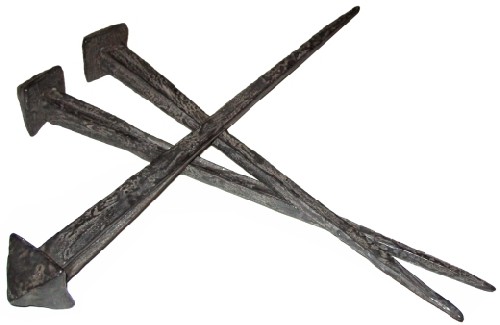
“Conan in agony, helpless, close to death –crushing the vulture’s neck in his teeth-enduring the ordeal of the felling of the cross –impatiently ripping the nails out of his feet with his mangled hands –holding onto the saddle on a frenzied mount… the episode dominates the story and the series. Better than any other scene, it underscores Conan’s barbaric vitality and indomitable soul. The scene overshadows the remainder of the story — and “A Witch Shall Be Born” is an excellent story. It is Conan at his best — defeated and condemned to a hideous death, fighting back through his barbaric strength and iron-willed determination, ultimately triumphant in the final battle, dooming his enemies to a just vengeance.”
Karl Edward Wagner, “Afterward,” The People of the Black Circle
While not every critic agrees that the story is excellent, all seem to agree that the crucifixion scene is hard to forget. In the same piece, Wagner remarks that even after forty years, Manly Wade Wellman recalled the scene vividly.
This seems an apt day to revisit Conan’s crucifixion. By the time Howard wrote the story, Wright had recognized the growing popularity of Conan by putting him on the cover spot with “Queen of the Black Coast,” “The Devil in Iron” and “The People of the Black Circle” and had now run out of stories to run. Howard could start to experiment a little, and he did.
The first thing that is different is that Conan only appears in a few key scenes. Much of the story is epistolary, that is, told by other observers, in letters and oral accounts, something Howard used occasionally elsewhere (like in “The Dead Remember” and “The Riot at Bucksnort” but not in a fantasy with a main character like Conan. It keeps the story short where it could have been a lengthy novella.
(Continue reading this post)
Wednesday, April 8, 2009
posted by Deuce Richardson
This has been an incredibly hard post to compose for a myriad of reasons. Steve Tompkins was nonpareil. His wit, his style, his awe-inspiring intelligence, his impact on Howard studies (and weird literature studies in general), his sheer output; there simply has not been any commentator on our beloved genre(s) quite like Mr. Tompkins. Many writers have pontificated about this or that aspect of weird/fantastic literature. Not one did so in quite the way that he did, nor did they do it quite so well, in this blogger’s opinion.
I never met Steve Tompkins (though we had a near miss at WFC ’06). I corresponded with him for about right on four weeks. Many others who knew him much better have already weighed in with praise for the man and his work. I can only give my perspective as a fan and as someone who hoped to call Steve Tompkins a friend someday.
(Continue reading this post)
Sunday, April 5, 2009
posted by Leo Grin
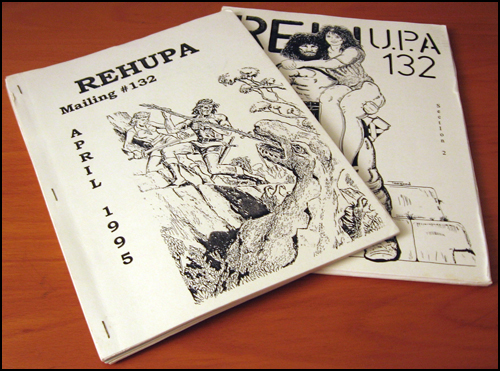
Six more mailings of REHupa are on eBay, filled to the brim with rare Howardiana.
For information on why REHupa mailings are rare, collectible, and an essential cornerstone of any good Howard collection, see here.
Saturday, April 4, 2009
posted by Leo Grin

Right on the heels of losing Steve, I’ve received word from Cross Plains that Joan McCowen died peacefully in hospice this morning after a long battle with cancer. For my tribute to her and her impact on Howard studies, go here. For a tribute to her late husband, go here.
I intend to write about Steve at length here at some point, but giving his life and influence in our field its proper measure is going to take far more than a boilerplate expression of grief or even an HPL-style memoriam. His prolificacy, his erudition, his humor, the way his diction and class and elevated style rubbed off on not only his fellow scholars but on Howard and the field as a whole — all of this and much more makes Steve’s death the worst loss in Howard fandom in my memory. I think back on all of the things he had his hands in: all of the inspiration he gave me, the education, the raw hard work whenever called upon, the hard knocks when deserved. It’s a staggering amount of influence and beneficence for one guy to have contributed, and it’s going to take awhile for us to understand how large is the gulf left behind by his absence. This is probably far more understandable to those of us who heavily relied on him than to those who merely saw his moniker on the occasional mega-essay. Speaking personally, we often clashed both politically and in terms of living life (as sad as his death is, I can’t say that it is entirely unexpected), but always in a friendly way, very much like HPL vs. REH in the way our disagreements tended to strengthen our friendship and mutually broaden each other’s minds rather than break us apart. Our friendship was based like a rock on a shared, achingly poetic love of Howard, Tolkien and their most talented predecessors and followers, going all the way back to Homer and all the way forward to guys like Charles Saunders. Whenever asked privately I would state that, along with Don Herron, Steve Tompkins was my very best friend in fandom, the guy who I felt most simpatico with as far as our intellectual assessments of the genre and of literature in general went. So much that I felt about fantasy and myth, Tolkien and Howard, things that everyone else seemed to be blind or uncaring to, Steve got 100%. It was truly wonderful to have him in my life as a sounding board for ideas, as a mentor (he was ten years older and far better read than I, and did much over the last decade to expand my literary horizons), and as a partner-in-crime on everything from REHupa to The Cimmerian to the blog to our private goals, hopes, and dreams.
There’s so much more to say about him, but it’s going to take me some time to properly gather my thoughts and get them organized. Until then, I can only mourn the loss of one of the all-time great Howardians. For once the tired cliché feels exactly right: our field will never see his like again, and his absence has left us much poorer.
Friday, April 3, 2009
posted by Steve Trout
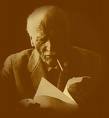
“It certainly does seem that certain individuals occasionally get in contact with forces outside themselves, something like cog-wheels grinding away in their spirits, that suddenly, perhaps only momentarily, slip into the notches of gigantic, unseen cog-wheels of cosmic scope. Maybe that’s what is meant by ‘getting in touch with the infinite.'”
-REH to CAS, undated.
Carl Jung introduced the idea of an archetype as a kind of prototypical concept, a basic building block of ideas. Jung thought of the archetypes as pychological “organs”, the product of mental or psychological morphology. Similarly, Jung believed the collective unconsciousness was a shared heritage bequeathed by our evolution, which shaped our minds just as it shaped our physical bodies.
Although we can study the genetic code that we carry for the shaping of our bodies, the collective unconsciousness can only be guessed at by the way it reveals itself to us in dreams, myth, religion and creative art. Through a life of study, Jung found that certain symbolic themes are universal. These archetypes are the hallmarks, the DNA, of the collective unconsciousness. Expanding on this, Joseph Campbell began working on the idea of a monomyth, a hero tale shared in its basic form by all cultures, even our pop culture; the monomyth involves a monumental task placed on a hero, who rises to meet the challenge through learning and growth (at the hand of a mentor of some sort, usually, who he will than grow to surpass).

It is not hard to see a similarity to the growth patterns of sons who learn from their father only to one day outstrip his abilities, as they grow to maturity while their father ages. Every individual must face his hero’s task in one way or another, if he is to find his own way in the world.
(Continue reading this post)
Wednesday, April 1, 2009
posted by Deuce Richardson
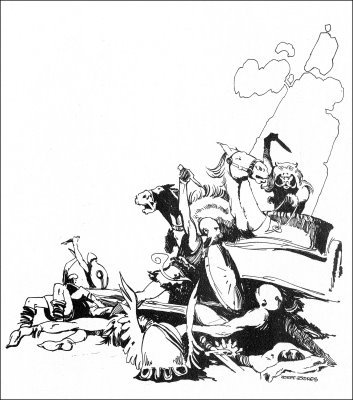
Such is the title of this most interesting blog post from John Sweat’s site, The Anthropogene.
As can be seen from the epigram that Sweat chose for his essay, the man is a Robert E. Howard fan. I am fairly certain that REH would be a fan of The Anthropogene as well, this blog post in particular. Howard was deeply interested in the expansion of the proto-Indo-Europeans/”Aryans” out of their homeland on the Eurasian steppes. He mentions their “epic treks” in numerous yarns. In addition, he had his primitive Hyborians (and Nordheimr) recapitulate (“precapitulate”?) the cultural ontogeny of the Indo-Europeans (as he saw it), right down to the wolf-skins and horse-hide tents.
For further reading on the proto-Indo-Europeans, I recommend any of J.P. Mallory’s books on the subject. Anthony’s The Horse, the Wheel, and Language is flawed, but still worth a read, in my opinion.
John Sweat’s fascination with catastrophism and lost civilizations parallels that of Robert E. Howard, so I’ll very likely revisit The Anthropogene’s treasure trove of essays for another blog, someday.
*Art by Jeffrey Jones








